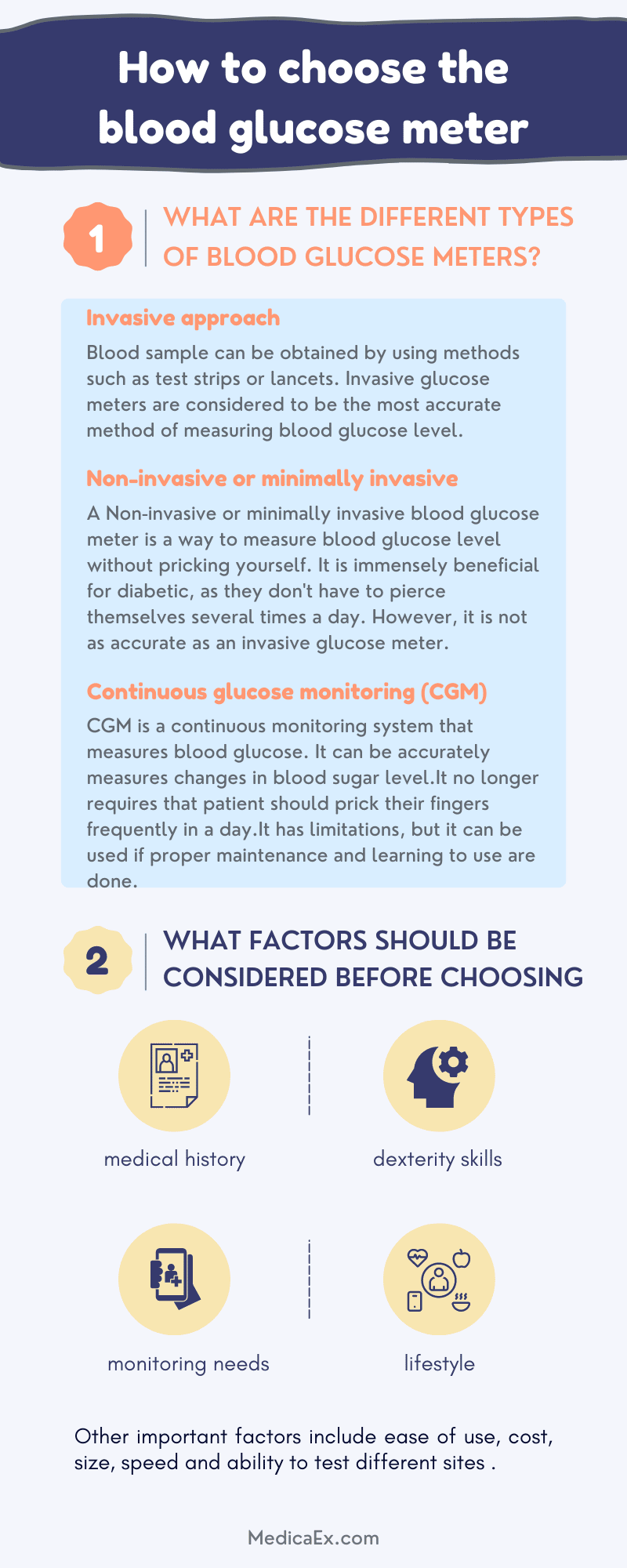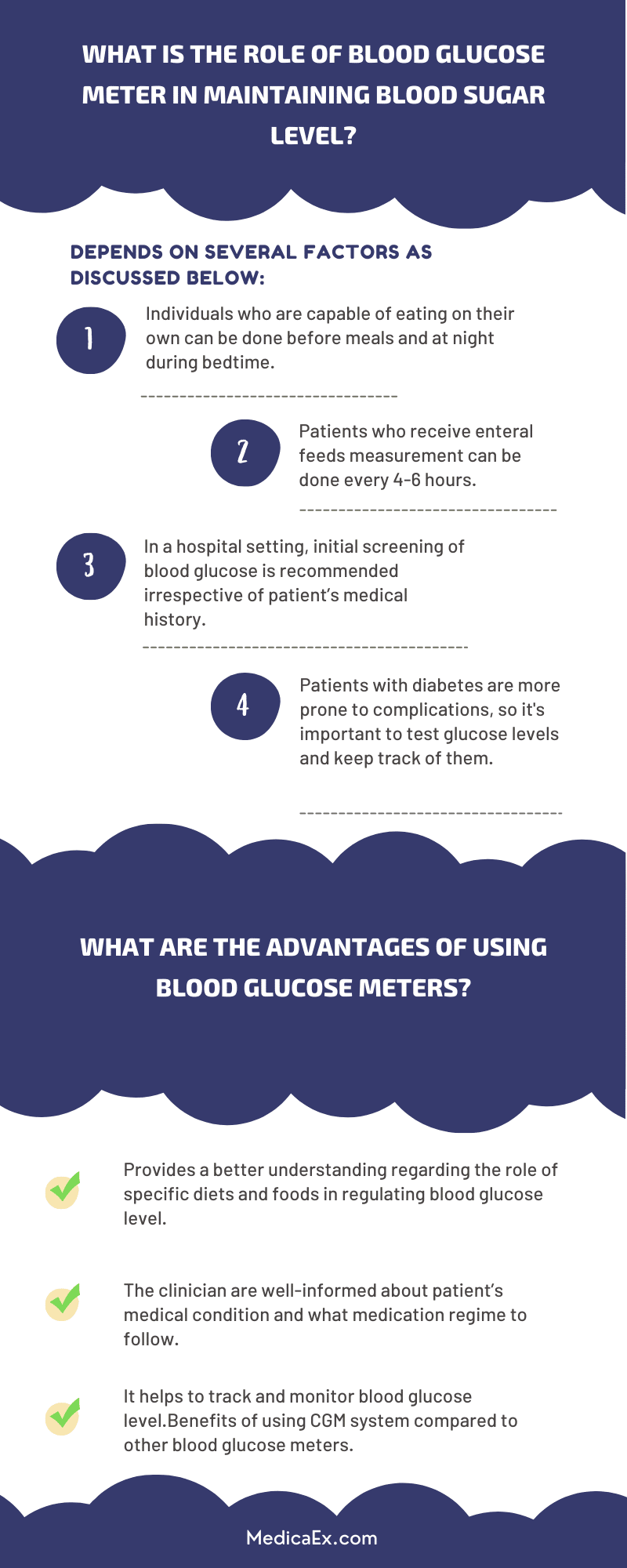Table of Contents
Monitoring blood glucose with the help of blood glucose meter is beneficial for testing the glucose concentration in the blood. Particularly, it plays an important role in management of diabetes. In assessing blood glucose level with the help of a blood glucose meter, blood is drawn by piercing the skin of finger, following which the blood is applied to a chemically active test-strip. The small drop of blood that is placed on a disposable strip interfaces with the digital meter. Within few seconds, on the digital display the blood level is shown.
As the meter requires only a small drop of blood which shows that the device helps to reduce time and effort necessary for testing. This also helps in increasing diabetic patient’s compliance. It is believed that the amount spent in using blood glucose meters is the cost benefit relative to minimize the scope of complications related to diabetes.
Different manufacturers adopt different technologies, and since past few decades determination of blood glucose level in blood is done with the help of a system that allows use of an electrical characteristic. The test usually refers to capillary blood glucose. Doctors advise patients with diabetes mellitus to regularly monitor their blood sugar level. Typically, test should be conducted at least once per day.
How to use blood glucose meters?
- Ensure that the meter is ready to use and is clean.
- Once a test strip is removed make sure that the test strip container is tightly closed. Moisture can damage test strips and that’s why it should be closed immediately.
- Wash your hands with a hand wash and warm water. Dry the hands and massage them so that blood reaches the fingers.
- Avoid use of alcohol as it may dry the skin excessively.
- A lancet is used for pricking the finger. Squeeze from the base of the finger and place a small drop of blood onto the test strip.
- The strip is then placed in the meter.
- Reading appears after few seconds. Track the results. In case if the reading is beyond the normal range it is important to add notes about the activity, food intake etc.
- The test strips can be stored in a container. Avoid exposing them to extreme heat, moisture and cold temperatures.
What are the different types of blood glucose meters?
They can be divided into several kinds as mentioned below:
Invasive approach
In this method, blood sample can be obtained by using methods such as test strips or lancets. These components are distributed in a kit form during the initial purchase. Invasive glucose meters are considered to be the most accurate method of measuring blood glucose level.
Non-invasive or minimally invasive
Recent advancement has focused on designing glucose meters that are based on physico-chemical sensors which can be kept at the measurement areas, mostly the arm. It allows detection of blood glucose level immediately as the meters scans the area. It is immensely beneficial for diabetic patients as they do not have to pierce themselves several times a day. There is no need for lancets or using test strips in non-invasive approach. Although, it is a painless method but it is not as accurate as the invasive glucose meter. Due to movement of the sensors it is difficult to use it effectively.
Continuous glucose monitoring (CGM)
This method is based on continuous monitoring of blood glucose level. There is a device placed on patient’s arm which is taken everywhere. It consist of a model which has an implantable sensor and a remote transmission system. With the help of CGM blood glucose level can be evaluated over a prolong period of time as it accurately measures changes in blood sugar level. The blood glucose level is evaluated from the interstitial fluid. It no longer requires that patient should prick their fingers frequently in a day. CGM has its own limitations as it needs proper maintenance and learning to use.
What factors should be considered before choosing blood glucose meter?
A thorough evaluation of patient’s medical history, medical situations, monitoring needs and dexterity skills should be considered.
- Depending on patient’s level of understanding and how comfortable they are, monitoring of blood glucose level by a glucose meter should be done. Hence, the device should fulfill the basic needs of patient as they will be using it throughout the day.
- Other important factors include ease of use, cost, size, speed and ability to test different sites such as palm and forearm. Few glucose meters provide benefits including graphic display, language choices, 12- and 24-hour timing and information documentation.
- Patient’s testing needs and lifestyle choices also should be considered before selecting glucose meter. Some patients may find it uncomfortable to proceed with blood glucose testing and that’s why they may avoid monitoring their blood glucose levels.
- In order to make it more comfortable for the patients, researchers are testing advanced meters which do not cause pain and are easier to use. Recent advances include adoption of noninvasive testing and testing at sites apart from fingertips.
- As the meter requires a drop of blood to assess blood glucose levels, therefore glucose meters will need a method to pierce the skin or use a lancing device.
What are the advantages of using blood glucose meters?
- Provides a better understanding regarding the role of specific diets and foods in regulating blood glucose level.
- The clinician are well-informed about patient’s medical condition and what medication regime to follow.
- Helps to be aware about hypoglycemia, and ways to manage it at home
- Reduces anxiety and concerns about patient’s medical status and complications related to it.
- It helps to track and monitor blood glucose level, especially if patient is undertaking any risky task where the blood glucose level may fluctuate. For example, long-distance driving and handling dangerous machines.
Benefits of using CGM system compared to other blood glucose meters
- Helps in evaluating glucose level regularly
- Requires less finger sticks
- Results in less medical emergencies associated with low blood glucose.
- Easier to track increase or decrease in blood glucose level by assessing changes in graphic on the screen. This will help to manage the glucose level immediately.
What is the role of blood glucose meter in maintaining blood sugar level?
Glycemic care and use of glucose meters depends on several factors as discussed below:
- Individuals who are capable of eating on their own blood glucose testing can be done before meals and at night during bedtime.
- Patients who receive enteral feeds measurement can be done every 4-6 hours.
- In a hospital setting, initial screening of blood glucose is recommended irrespective of patient’s medical history.
- Patients with diabetes are more prone to several acute and or chronic complications. It becomes important to create awareness and educate individuals to test their glucose levels. This include factors such as:
-Hand washing before testing
-Calibrating glucometer appropriately
-Proper use of lancet
-Adequate drop of blood sample
-Interpretation and understanding results
-Analysis and follow-up
What are the most recent tends?
Several developments have occurred including artificial pancreas technology. This technology substitutes manual blood glucose testing with insulin shots. This system tracks the blood glucose level around the clock and ensures that insulin and another hormone namely glucagon is provided when required. It can be assessed remotely by medical professionals and parents. A recent development was formulated in 2016 by Food and Drug Administration known as a hybrid closed-loop system.
Other technologies involve use of wireless network models and models with a speaking mode. Another recent technology can measure other parameters also apart from blood glucose levels. They are known as multiparametric models.
Conclusion
Blood glucose meters are a crucial tool that are commonly used for measuring blood glucose level in diabetics. They can be used comfortably at home, and provide accurate results in assessing blood glucose. Various types of blood glucose meters include invasive, non-invasive and continuous glucose monitoring. Each of these have their own unique features and offer several advantages. Depending on patient’s medical status, BGM should be selected that makes it simple and easy to track the glucose level routinely at comfort of the home.
Infographics










